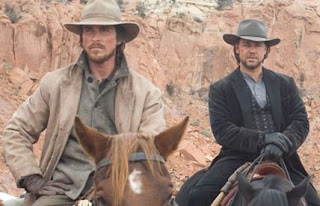It has been almost sixty years since Hollywood gave audiences High Noon-- the film that became the defining mold to the western genre. While directors and writers have spent years trying to reinvent the wheel, High Noon remains the quintessential western that all others follow in the footsteps of. High Noon effectively struck every note that has become cliché to western movies, but did so with such style and grace that the films that followed in its wake could not seem to help but try to take a shot at the formula. The classical western has faded in its popularity over the years, but recent Hollywood attempts to revive the dusty west still echo back to High Noon's classic mold.
According to Roger Ebert, "The Western in its glory days was often a morality play, a story about humanist values penetrating the lawless anarchy of the frontier" (http://rogerebert.suntimes.com/apps/pbcs.dll/article?AID=/20070906/REVIEWS/709060305). A classic western must at least in some manner illustrate this definition. Consider 2007's 3:10 to Yuma (a remake of a 1957 film of the same name) in which a down on his luck rancher undertakes the dangerous mission of escorting an outlaw to the train station. The story is so simple that it might have been rewritten any number of ways to accommodate the modern audience's fading interest in morality tales and westerns in general. Fortunately, the 2007 movie remains faithful to the spirit of the original film, which followed closely on the heels of High Noon.
Generally speaking, with exceptions of course, westerns require certain stock characters. These characters usually fall into the following categories: a pure-hearted hero of ordinary origins, the town barmaid, an antagonist of disreputable background, brainless lawmen, mercenaries, and one thoroughly good woman. The hero of High Noon is Marshall Will Kane, closely mirrored by 3:10 to Yuma's protagonist Dan Evans. The major difference between Gary Cooper's character Marshal Kane in High Noon and Christian Bale's Dan of 3:10 to Yuma is that the latter borders on mercenary but as the story shifts, so does he. What starts as a mission to save his ranch and earn back the respect of his family becomes a quest to be the agent of justice no matter the cost. In the process he saves his ranch and earns the respect of his family anyway.
Dis-similarly, Gary Cooper's Kane never alters his character. He is from the beginning determined to carry out his duties and remains resolute to the very end. The similarity between Dan and Kane is that before the film's inevitable shootout, both characters are completely abandoned by everyone, including lawmen and friends. Despite the certain outcome of going alone against a gang of lawless gunslingers, both men see their duties through while the other "good men" flee. Kane is driven by a sense of duty that the whole town (including his newlywed wife) tells him he does not have to bear. Dan is motivated by getting back on his feet financially and fulfilling his obligation to provide for his family. Both men are tested and forced to realize what they are truly made of. Both men stand firm even when the temptation to walk away seems practical, even reasonable.
The respective villains of High Noon and 3:10 are less similar to each other, but create the same moral dilemma for the protagonist. Frank Miller of High Noon and Ben Wade of 3:10 are both escaped notorious outlaws with a certain skill for evading justice. Between the two, Ben Wade is a far more interesting antagonist because he seems to exist to stir the waters whether by violence, indifference, or occasional kindness just for the sake of surprising himself. But just as Marshal Kane is an unyielding pure heart, his nemesis Miller must be equally constant in his evil. Wade does not shift so much in his character as much as he simply explores less visited sides to himself. Miller persists in his quest for vengeance without the slightest intention of faltering. Wade never truly ceases being the villain despite his charming attempts to manipulate the audience into liking him. Miller never tries to be liked; he cares about satisfaction. In the finale of both films, the hero is in a life-threatening character-testing moral dilemma created by the villains therein. Wade and Miller both have fiercely loyal gangs with no moral conscience that compound the danger that the heroes must face alone. It could be said that in each film, the heroes and villains mirror each other in their fortitude or in their growth.
Going back to Roger Ebert's quote about westerns being a morality play, both High Noon and 3:10 to Yuma effectively strike the proper note according to Ebert. High Noon laid the groundwork for the classic structure, and 3:10 to Yuma adhered to the established mode. 3:10 to Yuma may have rattled the cage in its more complex portrayal of the two main characters at odds with one another, but at its heart it is a strong tribute to classic westerns like High Noon in which evil will not triumph as long as good men do not stand by and do nothing.
